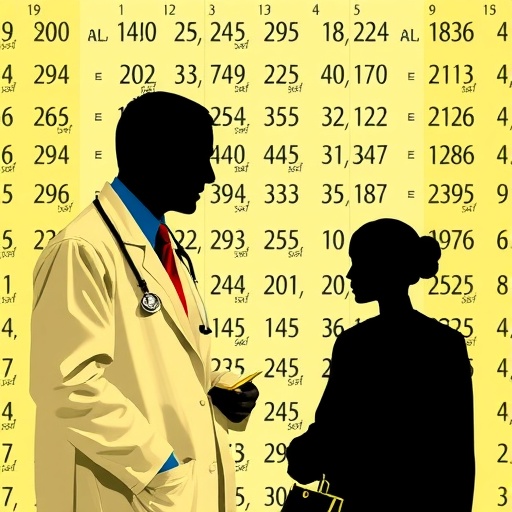In the complex world of healthcare, one of the most critical challenges is effective communication between physicians and patients, especially when discussing the risks associated with medical procedures and treatments. Physicians might casually say a procedure is “rarely risky,” yet such verbal phrases often leave patients confused or with an exaggerated sense of danger. Recent scientific exploration delves deeply into how numeric data presentation can transform patient understanding and decision-making in medical contexts, marking a pivotal advancement in shared healthcare communication.
At the heart of this inquiry lies a crucial realization: words alone are insufficient and sometimes misleading when conveying risk. A study recently published in the Journal of General Internal Medicine underscores the importance of pairing verbal descriptions with actual numbers to more accurately represent medical risks. When physicians rely solely on verbal descriptors such as “common” or “unlikely,” patients frequently overestimate potential side effects or misunderstand the likelihood of medical outcomes. This discovery is backed by empirical evidence that numeric communication clears misperceptions and fosters trust.
Ellen Peters, a psychology professor and a leading expert in science communication at the University of Oregon, has dedicated over two decades to investigating how patients interpret numerical information. Her research reveals a compelling paradox: despite concerns about many adults’ limited numeracy skills, the public often prefers to receive quantitative data when discussing health risks. Numbers, when properly contextualized, are perceived as more trustworthy, lending greater authority and credibility to physicians who provide them. This data-driven approach significantly improves patient adherence to medical advice.
A critical factor in this communication revolution is the manner in which numeric risk data is framed. Standard approaches that overwhelm patients with statistics can backfire, leading to confusion and reliance on irrelevant personal beliefs or anecdotal evidence. Instead, tailored and concise numerical information that aligns with an individual’s specific medical context can enhance comprehension and reduce cognitive overload. Physicians are encouraged to streamline information, focusing only on the most pertinent facts and eliminating irrelevant options from discussions, which facilitates clearer decision-making.
Moreover, the numeric data itself must be rendered in a digestible format. One advanced strategy is to convert abstract percentages into real-life projections that resonate with patients’ experiences—for instance, translating an annual risk into a cumulative risk spanning multiple years of treatment. This reframing helps patients better grasp the scale and duration of risks, bridging the gap between abstract statistics and their personal significance. By doing so, numeric information morphs from abstract data points into meaningful, actionable knowledge.
Contextualization also plays an indispensable role in numeric risk communication. Numbers, however precise, are meaningless without comparative or evaluative benchmarks. Describing a six percent risk as “poor” or comparing survival rates between treatments equips patients with a framework to understand whether a figure denotes high or low risk. Without such context, patients are left to interpret numbers in isolation, often leading to inaccurate conclusions and skewed risk perceptions.
Another subtle but vital layer of communication involves acknowledging the inherent uncertainty within risk estimates. Medical risk information is essentially a scientific best guess based on population data and current knowledge, but it cannot precisely predict an individual’s outcome. Transparency about these limits—explaining that risk percentages are not guarantees but estimates—can improve patient trust and readiness to engage with probabilistic information. When physicians explicitly communicate uncertainty, they equip patients to better weigh their choices without falling prey to false certainty.
One of the most powerful tools to cement understanding is the teach-back technique, a conversational strategy where healthcare providers ask patients to reiterate the information in their own words. This interactive method not only tests the effectiveness of communication but also identifies gaps in comprehension that can be immediately addressed. Instead of a generic “Do you have any questions?” physicians might say, “Can you explain what you understand about the side effects?” This tailored dialog supports a truly bi-directional exchange of information, underscoring shared decision-making.
These communication methodologies collectively hold the promise of transforming the patient experience. The era when patients passively received instructions is fading; today’s medical ethos emphasizes empowerment through comprehension. Patients who understand their treatment risks numerically and contextually are more likely to make informed choices, adhere to recommendations, and achieve better health outcomes. Such patient-centric strategies embody the future of evidence-based healthcare communication.
However, practical implementation requires a nuanced appreciation of diverse patient backgrounds. About one-third of American adults have limited numeracy, making it imperative to balance detailed numerical data with clarity and simplicity. Physicians must delicately calibrate their messages; data should neither overwhelm nor under-inform. By selecting communication strategies suited to each patient’s comprehension level and state of mind, healthcare providers can maximize engagement without causing unnecessary anxiety.
Integration of these strategies into routine clinical practice also demands time efficiency and scalability. Physicians encounter numerous patients daily and must repeat complex explanations efficiently. Therefore, developing quick, scripted, and adaptable communication approaches is vital. These can include standard phrasing for common scenarios, graphical aids to illustrate data, and decision aids customized for specific conditions. Such tools enable wider adoption while maintaining clarity.
Furthermore, this research opens avenues to explore the interplay between numeric risk communication and narrative elements such as storytelling and personal anecdotes. While numbers provide rigor and precision, stories touch emotional and psychological aspects that influence decision-making. Finding the optimal balance between quantitatively exact information and affective narrative could exponentially increase the effectiveness of physician-patient interactions.
In sum, the contemporary challenge of conveying medical risk is not just about translating statistics but about crafting meaningful, transparent, and empathetic communication. The recent findings by Peters and colleagues illuminate this path, emphasizing numeric expression paired with careful contextualization, acknowledgment of uncertainty, and interactive validation. As medical science advances, so too must the art and science of communication, ensuring that patients are not only informed but truly understand—the cornerstone of effective healthcare.
Subject of Research: Communicating numeric risk information effectively to patients in medical contexts.
Article Title: Communicating Numeric Risk Information to Patients
News Publication Date: 29-Apr-2025
Web References:
Original article DOI: 10.1007/s11606-025-09520-8
Ellen Peters profile: https://news.uoregon.edu/expert/ellen-peters-school-journalism-and-communication
Center for Science Communication Research: https://scr.uoregon.edu/
Keywords: health communication, numeric risk, patient decision-making, health literacy, shared decision-making, medical risk perception, teach-back technique, uncertainty in medicine, patient empowerment
Tags: effective doctor-patient communicationempirical studies on health communicationenhancing trust in healthcarehealth communication strategiesimportance of numeric communication in medicinemedical decision-making processesmisinterpretation of health risksnumerical data in healthcarepatient understanding of medical riskspsychology of health communicationrisks of medical proceduresverbal versus numeric risk presentation





